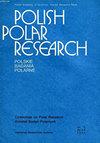Diversity of cyanobacteria and microalgae in hydro-terrestrial habitats in Svalbard and its ecological evaluation
IF 0.8
4区 地球科学
Q4 ECOLOGY
引用次数: 1
Abstract
Abstract: The aim of this research was to study the biodiversity of cyanobacteria and microalgae in hydro-terrestrial habitats from the area of Hornsund fjord (Svalbard archipelago). This research is particularly important, because hitherto no complex research (including all taxonomic groups) has previously been conducted on the cyanobacterial and microalgal flora in Arctic water ecosystems. The research was conducted during the summer seasons of 2011 and 2013. Shannon’s diversity index was used to describe species diversity and evenness. Data on cyanobacteria and microalgae were analyzed using the MVSP and PCA. Additionally, a basic analysis of the physicochemical properties of water in the studied ecosystems was performed. A total of 506 taxa were noted in the studied hydro-terrestrial habitats. The most numerous group was cyanobacteria, constituting 35% of all recorded taxa. Ochrophyta and Chlorphyta were almost equally numerous (percentage again as for cyanobacteria). Nineteen types of assemblages were noted in all studied hydro-terrestrial habitats. The diversity of cyanobacteria and microalgae and the assemblages formed by them were used to determine the characteristics of the studied ecosystems. Each type of water ecosystem was represented by specific phycoflora and assemblages. Ecological parameters along with biological data (the diversity of cyanobacteria and microalgae) allowed us to sort the studied hydro-terrestrial habitats by similarity. Our analyses clearly distinguished water ecosystem groups differing in species composition determining their trophic status. The research shows the usefulness of cyanobacteria and microalgae diversity defined by the Shannon-Weaver index for characterizing bodies of water and determining the trophic status of these habitats.斯瓦尔巴群岛水陆生境蓝藻和微藻多样性及其生态评价
摘要/ Abstract摘要:本研究旨在研究霍恩松峡湾(斯瓦尔巴群岛)水陆生境中蓝藻和微藻的生物多样性。这项研究特别重要,因为迄今为止还没有对北极水域生态系统中的蓝藻和微藻菌群进行过复杂的研究(包括所有分类群)。这项研究是在2011年和2013年的夏季进行的。采用香农多样性指数来描述物种多样性和均匀度。采用MVSP和PCA对蓝藻和微藻数据进行分析。此外,还对研究生态系统中水的理化性质进行了基本分析。在研究的水陆生境中共发现506个分类群。数量最多的是蓝藻,占所有记录分类群的35%。绿藻门和绿藻门的数量几乎相同(百分比再次与蓝藻门相同)。在所有研究的水陆生境中发现了19种组合类型。利用蓝藻和微藻的多样性及其形成的组合来确定所研究生态系统的特征。每种类型的水生态系统都由特定的藻系和组合来代表。生态参数以及生物数据(蓝藻和微藻的多样性)使我们能够根据相似性对所研究的水陆生境进行分类。我们的分析清楚地区分了不同物种组成的水生态系统群,决定了它们的营养状况。该研究表明,蓝藻和微藻多样性的香农-韦弗指数定义的有用性表征水体和确定这些栖息地的营养状况。
本文章由计算机程序翻译,如有差异,请以英文原文为准。
求助全文
约1分钟内获得全文
求助全文
来源期刊

Polish Polar Research
ECOLOGY-GEOSCIENCES, MULTIDISCIPLINARY
CiteScore
2.00
自引率
7.70%
发文量
0
审稿时长
>12 weeks
期刊介绍:
The quarterly Polish Polar Research edited by the Committee on Polar Research of the Polish Academy of Sciences is an international journal publishing original research articles presenting the results of studies carried out in polar regions.
All papers are peer-reviewed and published in English.
The Editorial Advisory Board includes renowned scientist from Poland and from abroad.
 求助内容:
求助内容: 应助结果提醒方式:
应助结果提醒方式:


